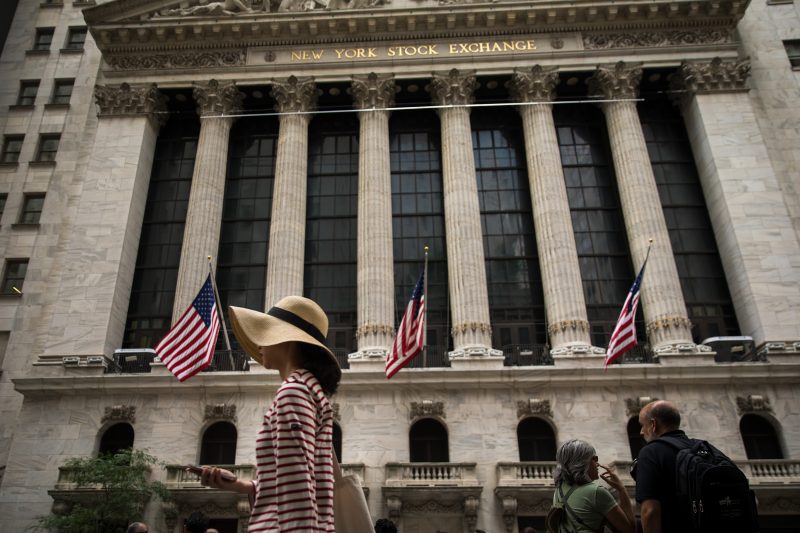Enough mansplaining: women tackle gender investment gap
Women are significantly less likely to invest in the market than men — and over a lifetime, that can translate into hundreds of thousands of dollars in lost income (Drew Angerer)
Washington (AFP) – As a professional woman in her late 30s, Kate Packard was keen to start investing. Like many novices, her enthusiasm took a knock when she hit a wall of impenetrable jargon — and was all but killed off by “mansplaining” from the men around her.
“They’ll be like, ‘Money is green! And it’s paper!'” said the strategic communications manager from Sterling, Virginia. “Yes, thanks, I can get there on my own.”
To do so, the 38-year-old turned to one of a growing number of groups run by women, for women — to help bridge the gender gap when it comes to investment.
Women are significantly less likely to invest in the market than men: based on studies from 2016 and 2017, the micro-investing app Acorns found 57 percent of women don’t invest at all, versus 44 percent of men.
Over a lifetime, that can translate into hundreds of thousands of dollars in lost income — and can hit particularly hard in countries like the United States, where wise investment can make the difference between hardship and comfort in retirement.
Confidence is key: 61 percent of women in the Acorns study felt they had a low level of understanding when it came to investing, compared to 43 percent of men.
“For the novice, it’s really intimidating,” said Pamela Sams, a financial advisor in Herndon, Virginia, who hosts regular group meetings for women like Packard who want to better manage their finances and investments.
– ‘Women need a safe space’ –
Packard’s account backs that up.
“I’ll see a word I don’t know, so I look it up. But then there’s another word I don’t understand. Suddenly I’m four definitions deep, and I’m tired and discouraged,” she said. “I wanted to be among women.”
Sams started the group in October 2018, including an online forum where members can post questions.
“Women need a safe space to really find out about these things,” she said.
Her experience has taught her many women aren’t comfortable handling longer-term investments, even if they feel fine managing daily finances.
Take the case of meeting attendee Shari True, a senior manager for a non-profit in Reston, Virginia.
True, 53, worked in a bank when she and her husband first started dating, and she handles their daily budget.
“It made sense that I would handle that,” she explained. Her husband does their taxes and manages their investments, since those were his before the marriage.
True and her husband have discussed their investments, but she never thought of taking them over.
“I never even considered studying finance or business in school, since it always seemed like such a male-dominated field,” she said. “It’s very intimidating.”
Packard echoed that message.
“When you read articles, they’re interviewing men, and they’re written by men, and on the websites, you only see male leaders,” she said.
“You don’t see women in the industry, so you develop an unconscious bias of ‘I’m excluded here.'”
– ‘Statistically better investors’ –
True and Packard are far from alone: only 27 percent of women feel their education prepared them to manage their own finances (versus 35 percent of men), according to the Acorns study.
Sheila Handler, a data and policy analyst in Washington, started looking into opening a market-linked retirement account in March — and found herself ill-equipped.
“My parents have tried to instill good money sense in me, such as saving aggressively, but the next step is never something we’ve talked about,” said the 24-year-old.
“Not that there’s any real chance of loss, but it’s such a large quantity of money!” she said. “So I feel overly cautious.”
A succession of studies has shown women to be more risk-averse than their male counterparts.
While this attitude can actually make them better investors — women outperformed men by 0.4 percentage points, in a Fidelity client data analysis for instance — it can also be what holds them back.
– ‘Somebody you can relate to’ –
While Handler is starting relatively early, a reluctance to invest can have heavy costs.
The women’s investment advising company Ellevest estimates that over a 35-year period, lower investment can cost anywhere from about $270,000 to more than $1 million, according to projections based on average salaries and standard asset allocation strategies.
But there are growing signs of companies tackling the issue — to get more women investing, and to chip away at the male-dominated culture that keeps them away in the first place.
Fidelity, for instance, hosts webinars aimed at teaching financial literacy to women. And there are non-profit organizations that recruit women into finance and asset management, aiming to create more diverse teams.
“It’s important you have somebody across the table you can relate to,” summed up Janet Cowell, CEO of Girls Who Invest, one such non-profit.
Disclaimer: Validity of the above story is for 7 Days from original date of publishing. Source: AFP.


